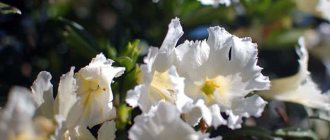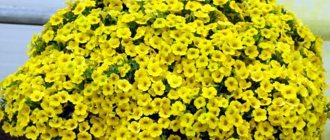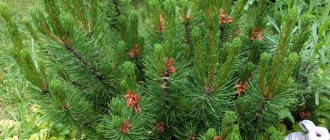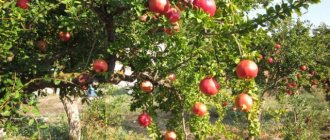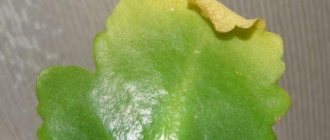When does the pomegranate bloom?
Home-grown pomegranate usually blooms twice a year. The first flowering occurs in the spring months - April and May. At this time, the ovaries of future fruits are formed from female flowers. The reappearance of ovaries and buds is detected in August - it lasts until about mid-September.
If the tree is planted in open ground, then in a warm climate it can bloom continuously. In Iran, in its historical homeland, the plant blooms all year round, delighting with its appearance and abundance of fruits. In central Russia, the flowering of an adult pomegranate tree begins in April and ends by mid-August. Southern regions boast a longer flowering period. Pomegranate trees are not planted in northern latitudes - the cold climate is not suitable for their cultivation.
Care to improve flowering
In its homeland, a heat-loving seedling can bloom all year round. In temperate climates, flowering occurs only in the warm season. In order for a tree growing in open ground to bloom more actively and longer, experts recommend following the following rules of care:
- water moderately (water should only be poured into the root zone; if moisture gets on the leaves, spots may appear on them);
- constantly cover the roots of plants with mulch (fallen leaves, straw, sweated manure);
- apply mineral and organic fertilizers (the latter should be applied carefully, since their excess only leads to an increase in green mass, slowing down the onset of flowering);
- periodically trim old, diseased branches, thin out the crown (anti-aging pruning is done every 25 years);
- in winter, cover the roots and branches (they are bent to the ground, sprinkled with soil, covered with spruce branches);
- carry out preventive treatment against pests and diseases.
Caring for indoor pomegranate consists of:
- watering (water at the root with settled water at room temperature);
- applying fertilizing (at the seedling stage, young trees are watered with an ash solution; subsequently, pomegranate trees are fertilized once every 2 weeks with liquid fertilizer for indoor plants);
- periodic inspection (to identify the presence of pests or signs of disease).
For indoor pomegranate, it is important to choose a suitable pot. It should be small. Planting a plant in a container that is too large will only cause it to grow and bloom poorly. The pot for replanting should be only 2 or 3 cm larger than the previous one.
How the pomegranate tree blooms
From the moment a flower appears until it disappears, only 3-4 days pass. However, the very next day new ovaries will appear. Thus, flowering does not stop even for a day; the pomegranate tree is in bloom almost all the time. And if you consider that at the same time budding and swelling of the fruits occurs, in the summer months the plant pleases with its incredibly beautiful appearance.
Flowers can be white, scarlet, yellow or crimson. Moreover, each of them can contain two or even three of these colors at once. This play of shades and variety of color options allows you to achieve a stunning picture. A blooming pomegranate looks great both in photos and in life.
general description
Pomegranate can be either a shrub or a tree. Under favorable natural conditions, it grows up to five to six meters.
At home, they grow a dwarf variety of the common pomegranate, which stops growing within one meter.
What is pomegranate?
Pomegranate is a small bush or tree with simple or double scarlet flowers and grey-brown bark. The plant branches abundantly, its shoots are short and crooked.
Small, elongated leaves shine beautifully and resemble the color of young grass. In leaf associations, some of them are noticeably larger than others. The surface of the leaf is leathery on top with glossy reflections, and matte on the bottom with an expressive vein.
Pomegranate leaves have short petioles, an ellipse shape and are located opposite each other. They are usually lanceolate, entire and oblong. They can reach eight centimeters in length and two in width.
Origin
The homeland of the pomegranate plant is Central Asia and North Africa. It is bred in the subtropics, considered the most useful and valuable source of essential microelements.
Where do pomegranates grow?
Pomegranate is grown in Iran, the Mediterranean and Crimea, as well as in many other countries. At the end of the eighteenth century, with the help of the Spanish conquerors, they began to breed it in America. In the wild, pomegranate grows on slopes, in areas of pine and oak forests.
Flowers
The flowers of the plant are wide, funnel-shaped, single or collected in a group, having many stamens and reaching five centimeters in size.
Pomegranate flowers are red or orange in color and are incredibly attractive, which is why most gardeners grow pomegranate at home precisely because of the flowers. They are located at the ends of the shoots or in the axils.
The flowers are bisexual, there are two types: with long and short pistils.
Flowers of the first type bloom on last year's shoots and in any case set fruit, flowers of the second type bloom on this year's shoots and do not form fruit. They are bell-shaped and have an underdeveloped ovary. They are smaller in size than the others, but they bloom magnificently, because there are more of them than fruiting ones.
For the above reason, the harvest may be much more modest than the flowering. The cups of the terry variety look like a bouquet with petals of bright color and wavy shape.
ATTENTION! Branches that are poorly developed cannot bloom; flowers appear only on powerful shoots.
Fetus
What kind of fruit does a pomegranate have?
The pomegranate fruit is a pomegranate; The berry is thick and leathery, with a brown pericarp, spherical in shape. It is mostly red, but yellow-green is also found. The weight of the fruit reaches six hundred grams. Inside it is divided into several nests containing two rows of grains.
Pomegranate seeds contain seeds that are located in the pulp - a juicy pulp that is suitable for consumption. Pomegranate seeds have a wide range of colors - from white to ruby.
The pulp of the berry is rich in color and tastes sourish-sweet. The diameter of the fruit can reach 18 centimeters; the color of the peel, along with dark red, can also be light orange. The juicy pulp makes up half the weight of the berry. One fruit can contain from two hundred to one and a half thousand seeds, groups of which are separated by beige partitions.
The berries ripen from September to February, but in the south this period gives way to a warm period - from March to May.
REFERENCE! The productivity of a pomegranate tree is determined by the remaining full-fledged flowers. They have a thick base that has a long column with a stigma.
When pollen lands on the stigma, a viscous liquid is formed that can retain the pollen and speed up its germination.
It is interesting that flowers, fruits and new ovaries can harmoniously coexist on a plant - this adds beauty and uniqueness. In warm areas, already ripe fruits crack while on the bush, retaining the seeds inside. From the outside it is an amazing sight.
What is the name of the pomegranate flower?
Pomegranate is a bisexual plant, so you can find both male and female flowers on it. Most often, both sexes are represented on the tree in approximately equal proportions, however, depending on the cultivated variety, the ratio may change in favor of more fruit-bearing female flowers. Also, climate and the agricultural technology used can play a certain role in the ratio of female and male specimens. Pomegranate flowers are very easy to distinguish from each other. Their name is generally accepted based on their appearance.
Important! The name of pomegranate flowers is the same in most countries. The similarity with everyday objects is so obvious that no one simply came up with other names.
Female flowers are usually called pitchers. This is explained by the similarity of the bud to a small vessel. Male pomegranate inflorescences are called bells. At the same time, male flowers are necessary only for pollination, so they do not bear fruit on their own.
Features of the plant
Pomegranate is a long-living plant. Its maximum height is from 5 to 6 meters in the subtropics and up to 20 cm when grown at home. Its distinctive features include the following:
- thin thorny branches;
- oval leaves are green, slightly shiny;
- orange-red flowers in the shape of a bell or jug;
- fruit with a brown-red or orange-yellow skin.
Fruits ripen only on mature plants that are more than 3 years old. The general period of its fruiting, depending on age, is from 7 to 40 years. Pomegranate blooms only under optimal conditions and if proper care is taken.
On a note! Plants of the coffee tree variety, indoor lemon, orange, mango and date palm grow well at home.
What does a pomegranate flower look like?
The female bud has a rather large and stable base and looks like a fleshy tube. Its jagged edge will remain on the ripe fruit in the future, forming a kind of crown. The pistil of female pomegranate flowers is long and located even slightly above the anthers.
Female flowers appear only on strong shoots of previous years. A multilocular ovary is formed from several fused stipules. Inside, it is divided among themselves by parts of the stipule, forming small chambers, which in the future will be filled with grains.
Important! Flowers of intermediate sex may be found on the tree. If it is more female, fruit formation is possible.
Male bluebells do not bear fruit in the future. Their appearance is a cone with a short pistil inside and tall anthers. They can form on fresh shoots. It is these flowers that amaze people with their magnificence. True, after flowering they die quite quickly.
Why doesn't pomegranate bloom?
There can be many reasons why a pomegranate refuses to bloom. When planted in open ground, damage to the tree can be caused by a variety of pests or diseases. In addition, there is a risk of damage to the pomegranate due to unsuitable climate. Also, the appearance of flowers may be due to improper processing of the pomegranate itself.
Do not forget that any tree is a living organism, which decides for itself how much fruit it can bear. If the root system and shoots are not fully formed, the tree will refuse to bloom, despite all the care and concern for it. Once the plant is ready to bear fruit, flowering will not take long.
Adverse climatic factors
One of the most serious problems for flowering pomegranates is return frosts. When a plant grown in open ground comes to life and opens buds and flower ovaries, a sudden cold snap can completely destroy them. In the event of such events, the pomegranate will either not bloom this year, or its flowering will be postponed to later months and will not be as abundant and lush.
Pomegranate is a very light-loving plant. It is estimated that a mature plant needs about eight hours of direct sunlight per day. If the required amount of sun is not received or the tree grows in a shaded place, the pomegranate will refuse to bloom and delight a person with its fruits.
For active flowering and fruiting, pomegranate requires fairly high relative humidity. In an apartment, it is quite easy to obtain ideal conditions. When growing a tree in open ground, in order to make it bloom, you will need to carry out a number of additional agrotechnical measures. In case of strong winds and long-term droughts, pomegranate leaves and flowers are sprayed with water using a spray bottle. It is also worth taking care of neighboring trees - the more plants there are, the more moisture they can retain.
Improper care
To stimulate the appearance of fruits and make pomegranates bloom, some experienced gardeners practice insufficient watering of the plant. The fact is that with a lack of moisture, the pomegranate begins to carry out the accelerated reproduction program inherent in every living creature, so the number of new ovaries in such a plant increases significantly. The disadvantage of this method is that due to your inexperience you can ruin even a healthy adult tree. In such cases, not only the new flower ovaries dry out, but even the shoots and root system.
Important! Do not suddenly stop the supply of water to the pomegranate. It is best to gradually reduce watering, observing its reaction in new conditions.
In order for an adult tree to bloom and bear fruit effectively, it is worth taking care of the correct formation of its crown. If the pomegranate is not trimmed on time, the roots will not have time to satisfy the needs of each shoot, as a result of which flowering will be delayed until the next season. Pruning should be done in early spring before the period of active swelling of the buds. It is important to cut the main branches of the pomegranate by about 1/4 - this will stimulate active growth of the crown. The shoots leading to the trunk are also trimmed. A 3-4 year old plant, devoid of unnecessary branches, will begin to bloom and delight its owners in April.
Diseases and pests
Pomegranate, like other plants, is susceptible to many diseases. They cause the greatest loss of ovaries in the spring, during the first flowering period. Among the diseases that contribute to a decrease in the number of pomegranate buds are:
- Powdery mildew. Pomegranate leaves and flowers become covered with a white coating and fall off quite quickly. The disease requires immediate treatment at the earliest stages. Spraying with Fundazol helps get rid of damage to leaves and flowers.
- Gray rot. Causes damage to flowers, shoots and fruits of pomegranate. Caused by excessive development of particularly dangerous fungi. Fungicides and antimycotic agents are used for treatment.
- Fomoz. With this disease, the skeletal branches die off. The pomegranate blooms, but the female buds become sterile. It is necessary to treat with Horus fungicide as soon as possible.
One should not discount insects, whose periodic attacks on fruit trees interfere with their active flowering and fruiting. One of the most dangerous pests for pomegranate is the whitefly. These insects stick to the leaves and branches of the tree, drinking all the juices from it, causing irreparable damage to the newly emerging ovaries.
Another dangerous insect for the plant is the pomegranate moth. It begins to destroy female buds when they begin to bloom, and also spoils the fruits that are already full. The best way to control insects is to use special insecticides. At the same time, it is better to give your choice to trusted manufacturers in order to be sure that the use of such poisons will not cause further damage to human health.
Diseases and pests
When growing a pomegranate tree, you may encounter some difficulties. Below are the main problems and the reasons for their occurrence:
- homemade pomegranate leaves dry out in conditions with dry air, low soil moisture, and also due to rotting of the root system;
- the roots rot when the plant is constantly overwatered, when moisture stagnates, drainage is impaired;
- burns on the leaves can occur in a weakened tree exposed to the scorching rays of the sun;
- spots on the leaves of homemade pomegranate appear as a result of frequent waterlogging of the soil, as well as due to the appearance of some viral or fungal diseases.
In addition, indoor pomegranate is often affected by pests such as whiteflies, codling moths, scale insects, aphids, and spider mites.
What to do if pomegranate does not bloom
The lack of new ovaries in a plant can upset any gardener. Experienced farmers advise refraining from special chemicals aimed at increasing their quantity. Such concentrates contain chemical compounds that can damage neighboring plants.
Important! Fertilizers for pomegranate are recommended to be used only when there are no other types of plants in the garden.
There are several simple agricultural techniques aimed at ensuring that the pomegranate tree begins to bloom as abundantly as possible. The first number among such measures is natural organic fertilizers with a small addition of complex plant additives. To prepare nutritious fertilizer you will need:
- 15 liters of water;
- 1 kg cow dung;
- 15 g of nitrogen fertilizers;
- 7.5 g of potash fertilizers;
- 12 g superphosphate.
All ingredients are mixed in a small barrel. Watering is carried out every 10-15 days from the end of March to mid-August. About 1 liter of ready-made fertilizer is poured under each bush at a time.
In order for a home pomegranate to bloom, an important task for a person is to select the optimal soil. The plant absorbs nutrients and blooms only in favorable conditions. The mixture should be light and consist of turf soil and humus. As an additive, you can use old plaster and a little bone meal. Dry cow dung can also be used as drainage.
To speed up the flowering of pomegranate at home, farmers practice the technology of periodically replanting pomegranates. The new pot should be 2-3 cm larger than the previous one. It should be understood that traditionally pomegranate blooms better in cramped conditions. If the roots have plenty of space and nutrients, the plant will only increase its green mass.
Important! The ideal pot for pomegranate is considered to be one that still limits the intensive growth of roots.
A very important technique for increasing the number of flowers on a future tree, as paradoxical as it may sound, is to give the plant rest. When a young plant begins to bloom, the ovaries are torn off so that the roots and branches become stronger and can increase their productivity in the future.
If none of the methods brings the desired result, you can use a last resort. A shoot is cut off from a healthy pomegranate that has been blooming for several years and grafted onto the trunk of a young tree. This method can also make it possible to combine several varieties in one plant.
How many years does it take for pomegranate to bloom after planting?
The beginning of the flowering period largely depends on proper planting and care of the plant in the first years of its life. It is believed that a pomegranate planted from a seed actively gains green mass for the first 2-3 years and only in the 4th year of life begins to delight its owners with abundant bright flowers. For pomegranate trees planted as seedlings, this period is slightly reduced - on average, they begin to bloom starting at 3 years of age.
Young plants may flower abnormally early. The first buds may appear as early as 2 years of pomegranate life. As a rule, such single specimens fall off quite quickly, since the tree is not yet ready to bear fruit.
Blooming pomegranate in nature
The homeland of the pomegranate tree is Iran, so its usual habitat is a desert, dry climate. The flowering plant crop presents an unsurpassed landscape. First, abundant foliage appears, its color can be from a gentle yellow to a bright emerald hue. After a few days, buds appear. This happens from early summer to early autumn. This process is continuous, so forming and ripened fruits, their ovaries and unopened buds can simultaneously appear on one branch.
You may be interested in:
Why doesn’t hydrangea bloom, what should I do? Hydrangea is considered a perennial plant. Her...Read more...
What do the deadlines depend on?
The timing of when and how pomegranate flowers grow depends only on how well the growing conditions are met. In warm regions this occurs in the summer, for example, in Georgia, Abkhazia, Armenia, Azerbaijan, Uzbekistan and Tajikistan, and in the subtropics it can continue throughout the year. When growing in unfavorable climatic conditions, provide the plant with artificial light and heat. But even in this case, only empty “male” flowers that are not capable of forming ovaries can grow.
How many years does it take for pomegranate to bloom after planting?
The initial option for growing flowering pomegranates is to plant a seed. After this, the plant grows and matures; already in 3-5 years it is capable of flowering and bearing fruit. When propagated by cuttings, this happens faster, the flowering process appears after 1-2 years, but the first fruits will appear only after 3-4 years.
